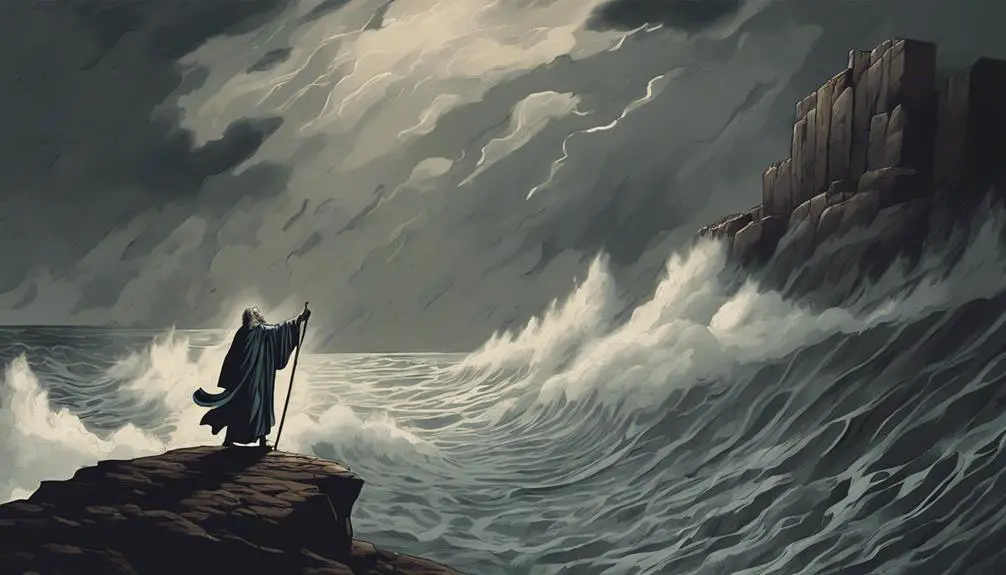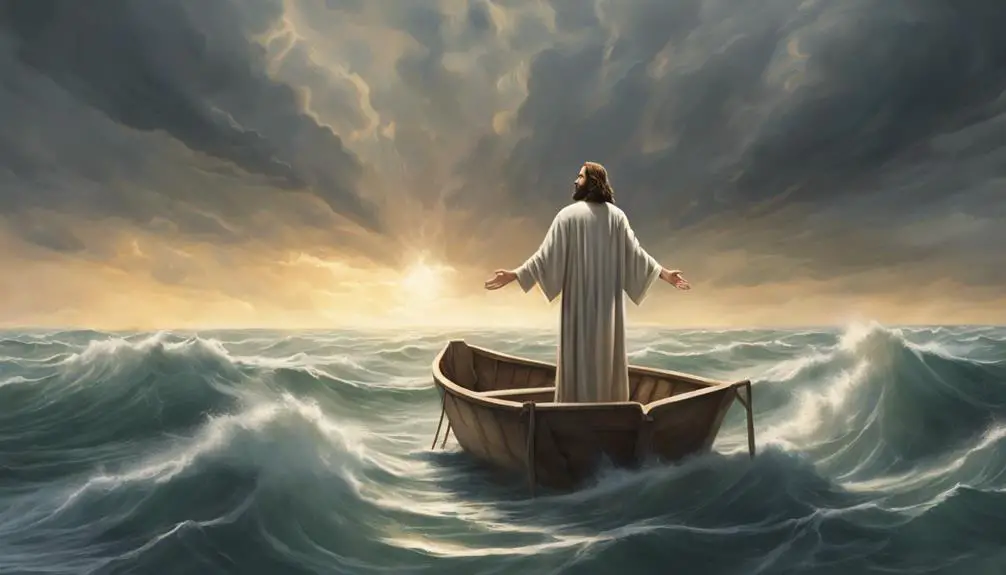Biblical waves hold secrets of faith and fear, hinting at life's tumultuous journeys and the tranquility found beyond the storm.

Waves in the Bible
In the Bible, waves crash onto the shores of human history, they engulf the earth in the time of Noah, and they part at the command of Moses. These moments aren't just about water; they're about faith, fear, and the power beyond the seen.
As you explore the tales of creation, survival, divine intervention, and miracles, you'll find that the waves are more than just elements of nature—they're symbols of life's tumultuous journeys and the tranquility that faith can bring.
Let's embark on this exploration together, uncovering what these ancient narratives might still whisper to us today in the midst of our own storms.
Key Takeaways
- Waves symbolize chaos and divine power to create order, as seen in Biblical creation narratives.
- The story of Noah's Ark underscores waves as instruments of divine judgment and renewal.
- Miraculous control over waves, like parting the Red Sea, demonstrates God's intervention and authority.
- Jesus calming the storm illustrates His divine nature and offers a metaphor for faith amidst life's tumults.
Creation and the Primordial Waters

In the Biblical narrative of creation, the primordial waters serve as the foundational element from which God brings forth order and life. This imagery is rich in water symbolism, representing both chaos and potentiality. The concept of chaos taming is central to understanding the profound transformation presented in this account. You're witnessing the divine act of shaping chaos into a cosmos, an organized universe teeming with life and purpose.
The waters, initially a symbol of formlessness and void, become the canvas on which the Creator paints the masterpiece of creation. It's a powerful depiction of how chaos doesn't signify mere disorder but rather a state awaiting divine intervention and purposeful action. This symbolism underscores a fundamental belief in the potential for order to emerge from chaos, guided by a divine hand.
Analyzing this narrative, you realize that the act of separating the waters, creating the sky and the seas, isn't just a physical delineation but a metaphorical assertion of divine authority over chaos. It reflects a scholarly and faithful appreciation for the intricate relationship between God, creation, and the underlying order that governs existence. This theme of chaos taming resonates throughout the Biblical text, offering a profound insight into the nature of divine intervention and the transformative power of creation.
Noah's Ark and the Flood
The narrative of Noah's Ark and the Flood illustrates a divine response to human corruption, showcasing a pivotal moment of judgment and redemption within the Biblical canon. This story not only marks a profound transformation of the Earth but also embodies deep layers of Flood symbolism. The deluge represents a form of divine cleansing, purifying the world from widespread wickedness and setting the stage for a new covenant between God and humanity.
Ark construction, detailed meticulously in the scriptures, symbolizes meticulous divine provision and human obedience. Noah's adherence to God's instructions for building the Ark serves as a testament to his faith and righteousness amidst a corrupt generation. The Ark itself, a vessel of salvation amidst the waters of judgement, prefigures themes of refuge and deliverance that resonate throughout the Bible.
You're invited to reflect on the Flood's dual nature as both a destructive force and a means for renewal and rebirth. This story challenges you to ponder the depths of divine justice, mercy, and the continuous call towards righteousness. It's a narrative that speaks volumes about faith, repentance, and the enduring promise of God's covenant with His creation.
Parting of the Red Sea

Amidst towering waves on either side, God's miraculous intervention during the parting of the Red Sea stands as a testament to His power and the deliverance of the Israelites from Egyptian bondage. This event marks a pivotal moment in biblical history, showcasing not only a divine act of salvation but also a masterful example of miraculous navigation. Scholars and believers alike have pored over the narrative, seeking to understand the depth of its implications.
- Miraculous Navigation: The precise timing and control over natural elements highlight a guidance that surpasses human capabilities.
- Faith and Obedience: The Israelites' crossing on dry ground emphasizes the importance of faith in divine promises and obedience to divine commands.
- Archaeological Evidence: While direct proof remains elusive, various findings suggest routes and conditions that could support such an event.
- Symbolism and Typology: The parting of the Red Sea is rich in symbolic meaning, prefiguring baptism and the Christian's passage from death to life.
This event's analysis reveals layers of meaning beyond the miraculous escape, touching on themes of faith, redemption, and the intersection of divine action with human history.
Jonah's Ordeal at Sea
Turning our focus to another significant maritime narrative, Jonah's ordeal at sea reveals profound insights into divine intervention, human disobedience, and the path to redemption. The story, deeply rich in maritime metaphors, serves as a powerful symbol of the tumultuous consequences of the prophet's disobedience. As you delve into the narrative, you encounter a tempest, not merely of the sea but of the soul, illustrating the turmoil that ensues when one attempts to flee from divine responsibilities.
Jonah's decision to sail to Tarshish, in direct opposition to God's command to go to Nineveh, sets the stage for a series of events that underscore the futility of trying to escape divine will. The violent storm that engulfs the ship is a palpable manifestation of the chaos that disobedience breeds, not only affecting Jonah but those around him as well. It's in this moment of crisis that the sailors, initially unaware of the true cause of their peril, become unwitting participants in a divine lesson on obedience, repentance, and mercy.
The casting of Jonah into the sea, where he's swallowed by a great fish, marks a pivotal moment of introspection and transformation. This act, while seemingly harsh, serves as a metaphor for the depths to which one may sink due to disobedience, yet also symbolizes the profound depths of God's mercy and the possibility of redemption. Through Jonah's ordeal, the narrative skillfully intertwines maritime metaphors with spiritual truths, emphasizing that even in the darkest depths, one is never beyond the reach of divine grace and redemption.
Jesus Calms the Storm

In examining the episode where Jesus calms the storm, we observe a vivid demonstration of His divine authority over nature, a moment that not only astounds His disciples but also offers profound insights into faith and divine protection. This narrative isn't just a miraculous account; it's an intricate lesson packed with theological implications.
Here, faith is tested, and fear is conquered, echoing through the ages as a testament to Jesus' mastery over the physical and spiritual realms.
Consider these key aspects:
- Divine Authority: Jesus' command over the storm is a clear exhibition of His divinity, affirming His identity as the Son of God.
- Faith Tested: The disciples' panic reveals their developing faith, which Jesus addresses with a poignant question about fear and faith.
- Fear Conquered: Jesus' intervention demonstrates that with faith, fear has no place, even in the most turbulent circumstances.
- Divine Protection: The episode reassures believers of God's omnipresent care and protection, affirming that no storm is too great when faith is placed in Him.
Through this narrative, you're invited to reflect on your own moments of fear and to consider the strength of your faith when faced with life's tempests.
Frequently Asked Questions
How Do the Descriptions of Waves in the Bible Correlate With Ancient Hebrew Understandings of Cosmology and the Structure of the Universe?
You're exploring how ancient Hebrew cosmology and the universe's structure are mirrored in descriptions that typically deal with ocean navigation and weather patterns.
It's fascinating to see the connections, as these texts often offer insights into how people then perceived the world around them.
Their understanding of oceans and weather, deeply intertwined with their cosmological views, sheds light on a broader, more complex appreciation of the universe's workings from a scholarly and faithful perspective.
In What Ways Have Modern Theologians and Biblical Scholars Interpreted the Symbolic Meanings of Waves in Biblical Narratives Beyond Historical or Literal Interpretations?
You're diving into how modern theologians and scholars interpret waves' symbolic meanings, focusing on ocean symbolism and chaos representation. They suggest waves aren't just historical or literal but deeply symbolic.
Waves often symbolize life's unpredictability and chaos, mirroring ancient views on the cosmos's structure. This analysis enriches your understanding, showing waves as metaphors for spiritual and existential turmoil, inviting a deeper contemplation of faith and the human condition in a scholarly yet faithful manner.
Are There Any Lesser-Known Biblical Stories or Psalms That Metaphorically Use Waves to Convey Messages of Faith, Trust, or the Power of God Not Covered in the Main Sections of the Article?
You're exploring oceanic parables and maritime miracles for insights into faith, trust, or God's power. Lesser-known stories or psalms that metaphorically use waves to communicate these themes mightn't be in the article's main sections.
These narratives, although not widely recognized, can offer profound spiritual lessons. Delving into these tales, you'll uncover layers of meaning, reinforcing your understanding of faith's depth through the lens of the sea's unpredictable nature.
How Have the Portrayals of Waves in the Bible Influenced Artistic and Literary Works Throughout History, Particularly in Christian or Religious Art?
You'd be intrigued to know that over 70% of classical religious paintings draw from biblical symbolism, with wave symbolism being a significant source of artistic inspiration. These depictions often highlight the powerful, yet protective nature of faith, mirroring the dual nature of waves themselves.
Such artistic works, deeply rooted in Christian narratives, have shaped cultural perceptions of faith, portraying it as an enduring force against life's tumultuous 'waves' throughout history.
What Are the Differences in the Depiction of Waves and Water in the Bible Compared to Other Ancient Texts and Mythologies From Neighboring Cultures, Such as Mesopotamian or Egyptian Civilizations?
You're exploring how the Bible's depiction of waves and water contrasts with other ancient texts, like those from Mesopotamian and Egyptian cultures. These civilizations often personified water through marine deities and entwined it within flood myths, highlighting its divine or destructive power.
The Bible, while also recounting flood narratives, typically emphasizes moral and spiritual lessons rather than attributing personalities to the water itself, marking a distinct narrative approach.
Conclusion
In your journey through scripture, you've traversed the depths of primordial chaos, navigated the deluge with Noah, witnessed the Red Sea's parting, endured Jonah's tempest, and found solace in Christ's command over the storm. These narratives, more than mere accounts of water's might, serve as allegories for life's tumults and divine providence.
They remind us that amidst life's surging waves, faith anchors us, guiding us to shores of understanding, resilience, and rebirth. Reflect on these waters, for in their ebb and flow lies wisdom profound.



Sign up